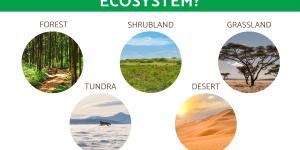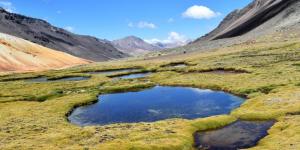What Are Polar Ecosystems?


The polar environment is one of the most fascinating and challenging regions on Earth. It's a place of extremes, where the temperature can drop to -50°C or lower, and the sun doesn't rise or set for months at a time. Despite the harsh conditions, the polar regions are home to a unique and diverse range of wildlife, including polar bears, penguins, walruses, and seals.
In this article from thedailyECO, we will explore the polar environment in more detail, looking at the geography, climate, and wildlife of this remarkable region.
What is the polar ecosystems?
A polar ecosystem is a complex and interconnected web of living organisms and their physical environment that exists in the polar regions of the Earth, encompassing both the Arctic and Antarctic regions. It is a unique and fragile ecosystem that is characterized by extreme cold temperatures, long periods of darkness and daylight, and a harsh and unpredictable climate.
The polar ecosystem is defined by the presence of a variety of habitats, including sea ice, glaciers, ice shelves, tundra, and open ocean. Despite the inhospitable conditions, the polar environment is home to a wide variety of animals that have adapted to survive in these extreme conditions.
The polar ecosystem is also home to a rich diversity of plant life, which play a critical role in the ecosystem by providing food and shelter for other organisms. Additionally, the polar regions are home to a variety of marine organisms, such as krill, phytoplankton, and fish, which form the base of the food chain and provide a vital source of food for larger predators.
Unfortunately, the polar ecosystem is also highly vulnerable to environmental changes, including climate change and human activities such as pollution and overfishing. The delicate balance of the polar ecosystem can be easily disrupted, leading to cascading effects throughout the food chain and potentially catastrophic consequences for the entire ecosystem.
Be sure to check this other article, where we have listed all the different types of ecosystems.
Characteristics of the polar ecosystem
In this section, we will explore the distinguishing features of the polar environment. Let's dive deeper into what makes the polar environment so unique and to better understand how life has adapted to thrive in these extreme conditions.
- Extreme cold temperatures: the polar regions are known for their bone-chilling temperatures, which can reach as low as -50°C or lower.
- Long periods of darkness and daylight: due to the Earth's axial tilt, the polar regions experience extended periods of darkness and daylight, with the sun either continuously above or below the horizon for several months at a time.
- Harsh and unpredictable weather: the polar environment is prone to extreme weather conditions, including blizzards, snowstorms, and gale-force winds.
- Polar ice caps and glaciers: the polar regions are home to some of the world's largest ice caps and glaciers, which are melting at an alarming rate due to climate change.
- Unique and diverse wildlife: despite the inhospitable conditions, the polar environment is home to a wide variety of animals, including polar bears, penguins, walruses, seals, and arctic foxes, many of which have adapted to survive in these extreme conditions.
- Fragile and vulnerable ecosystem: the polar environment is a fragile and vulnerable ecosystem that is highly sensitive to climate change and human activities, such as oil and gas exploration and overfishing.
- Scientific research opportunities: the unique conditions of the polar environment offer a wealth of opportunities for scientific research, including studies on climate change, oceanography, and astronomy.
- Icebergs and pack ice: the polar regions are also known for their vast expanses of icebergs and pack ice, which can be both mesmerizing and treacherous for ships and other vessels.
You might be interested in this other article, where we delve into the characteristics and biodiversity of jungle ecosystems.

Fauna of the polar ecosystems
The fauna of the polar regions is both diverse and fascinating, with a wide variety of animals that have adapted to survive in some of the harshest conditions on the planet. These animals have evolved unique strategies to cope with the extreme cold, darkness, and isolation of their environments.
Mammals
- Polar bears (Ursus maritimus): these majestic creatures are the largest land carnivores in the world and are perfectly adapted to the icy conditions of the Arctic. They primarily feed on seals and other marine mammals.
- Arctic foxes (Vulpes lagopus): these small, fluffy creatures have thick fur that changes color with the seasons, allowing them to blend in with their surroundings. They feed on small mammals and birds, and have been known to scavenge from polar bear kills.
- Reindeer (Rangifer tarandus): these large, antlered animals are a common sight in the Arctic tundra, where they feed on lichens and other vegetation.
Marine mammals
- Orcas (Orcinus orca): these highly intelligent and social animals are apex predators in the polar oceans, and are known to hunt a variety of prey, including seals, sea lions, and even other whales.
- Walruses (Odobenus rosmarus): these large, tusked animals are well-adapted to life on the sea ice, and use their tusks to pull themselves out of the water onto the ice. They feed on clams and other shellfish.
- Harp seals (Pagophilus groenlandicus): these adorable, fluffy animals are a common sight on the sea ice in the Arctic, where they give birth to their young. They feed on fish and other small marine animals.
Birds
- Penguins: although they are most commonly associated with the Antarctic, several species of penguins can also be found in the Southern Ocean and around the sub-Antarctic islands. For example, the emperor penguin (Aptenodytes forsteri) is the largest penguin species and can be found in Antarctica. They feed on fish and other small marine animals.
- Snowy owls (Bubo scandiacus): these majestic birds of prey are well-adapted to life in the Arctic, where they feed on small mammals such as lemmings and ptarmigan.
- Arctic terns (Sterna paradisaea): these migratory birds have the longest migration of any bird species, traveling from the Arctic to the Antarctic and back each year. They feed on small fish and other marine animals.
Fish
- Arctic char (Salvelinus alpinus): This species of fish is found in freshwater lakes and rivers in the Arctic, and is an important food source for many animals, including humans.
- Antarctic cod (Dissostichus mawsoni): This species of fish is found in the waters surrounding Antarctica, and is well-adapted to life in the cold and icy conditions.
- Lanternfish (Gymnoscopelus nicholsi): These small, bioluminescent fish are found in the Southern Ocean and are an important food source for many larger marine animals.
Amphibians and reptiles are not found in polar ecosystems. This is because they are ectothermic animals, which means that their body temperature is regulated by their environment. They require warm temperatures to survive and are not well-suited to the extreme cold of the polar regions.
Do not miss this other article, where we explain what sea ice is.
Flora of the polar ecosystems
The flora of the polar ecosystems is characterized by a low diversity of species, but a high degree of specialization and adaptation to the extreme environmental conditions. In the extreme cold and darkness of the Arctic and Antarctic, plant life has evolved unique strategies to survive and reproduce. Let us look at some examples of common species of flora in the polar ecosystems:
Mosses, lichens, and algae
- Arctic Moss (Polytrichum juniperinum): is a common moss species found in the Arctic tundra. It is adapted to the cold and windy environment, and is able to grow even on bare rock surfaces.
- Reindeer Moss (Cladonia rangiferina): is a type of lichen that is an important food source for reindeer and other herbivores in the Arctic. It is found in open, dry areas and can grow in a variety of shapes and colors.
- Snow Algae (Chlamydomonas nivalis): is a type of algae that grows on snow and ice surfaces in the Arctic and Antarctic. It is able to survive in extremely cold temperatures and is an important part of the polar food web.
Grasses and sedges
- Arctic Cotton (Eriophorum scheuchzeri): is a type of grass that is found in Arctic and Alpine environments. It is able to grow in cold and wet conditions and has adaptations that help it conserve water.
- Tufted Hairgrass (Deschampsia cespitosa): is a type of grass that is found in Arctic and Alpine tundra environments. It is able to grow in cold and windy conditions and provides important habitat for small mammals and birds.
- Polar Willow (Salix polaris): is a type of willow that is found in Arctic and sub-Arctic environments. It is able to grow in cold and wet conditions and is a significant food source for herbivorous animals.
Shrubs
- Arctic Blueberry (Vaccinium uliginosum): is a small, low-growing shrub that is found in Arctic and sub-Arctic environments. It is able to grow in cold and nutrient-poor soils and provides essential food for many animals, including birds and mammals.
- Dwarf Birch (Betula nana): is a small shrub that is found in Arctic and sub-Arctic environments. It is able to grow in harsh conditions and provides crucial habitat for birds and small mammals.
- Crowberry (Empetrum nigrum): is a low-growing shrub that is found in Arctic and sub-Arctic environments. It is able to grow in nutrient-poor soils and provides significant food for many animals, including birds and mammals.
Polar flora have unique features that distinguish them from other plant species. They usually have a low-growing habit, accompanied by shallow roots and thick, fleshy leaves that enable them to conserve water and nutrients in the harsh polar environment. Furthermore, many polar plants can reproduce vegetatively, utilizing methods like clonal growth and fragmentation, which do not depend on seeds for propagation.
Lastly, be sure to check this other article, where we explain what aquatic ecosystems are.
If you want to read similar articles to What Are Polar Ecosystems?, we recommend you visit our Ecosystems category.
- Bjorkman, AD, Garcia Criado, M., Myers-Smith, IH et al. Status and trends in Arctic vegetation: Evidence from experimental warming and long-term monitoring. Ambio (2019). https://doi.org/10.1007/s13280-019-01161-6






